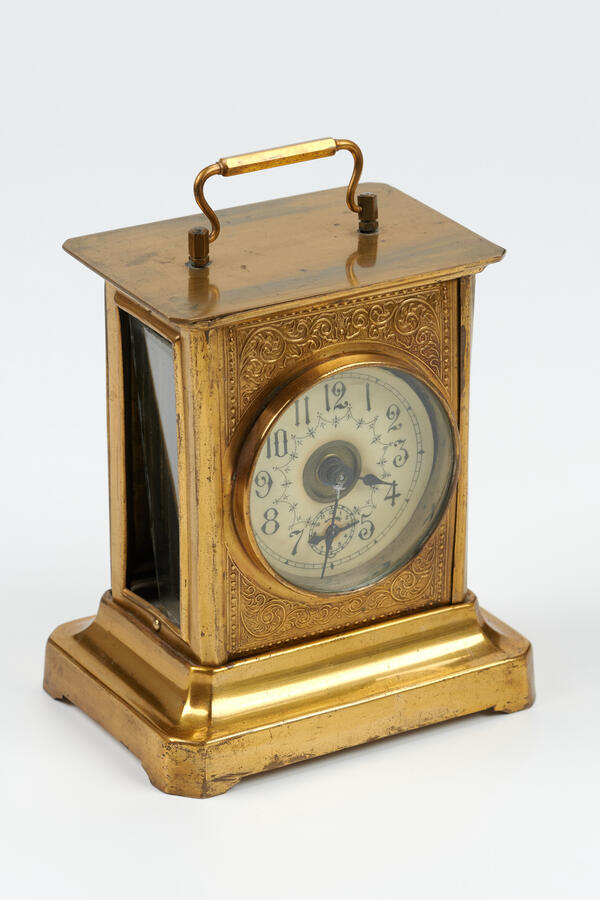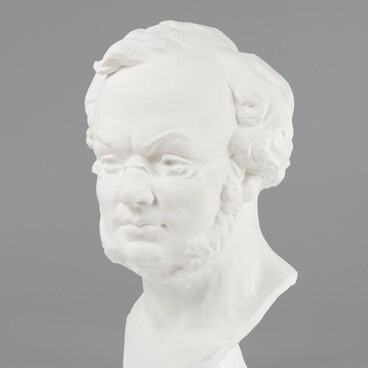Collector Sergey Chepkasov donated the carriage clock to the Yershov Museum Complex of Ishim City in 1993. Now the exhibit is displayed at one of the permanent exhibitions of the museum — ‘The Moscow-Siberian Tract’.
The clock with an installed musical alarm was made at a German factory in the late 19th-early 20th centuries. The ‘Karetniki’ (the short name of the carriage clock), unlike the household clocks, were always on the road, so the designers had to protect the mechanism from vibrations and guarantee the accuracy of the clock. The clocks, used on the road, were considered as special-purpose devices, and not household devices.
The first ‘karetniki’ appeared in France, they were made for Napoleon Bonaparte by a renowned clockmaker of the time Abraham-Louis Breguet. Napoleon was monitoring the discipline of his senior officers. Among other things, the officers needed reliable and accurate clocks that could be with them 24 hours a day at their homes and on trips. When clockmakers received the order for the carriage clock, it was accompanied by a note — ‘clocks for the officers’. That is why they are called ‘Officers' Clocks’.
The shape of the carriage clock has not changed for more than a hundred years. They could be recognized by the vertical rectangular case with a convenient carrying handle. The clocks were transported in a leather-covered box. The clock had to be always equipped with the striking feature. In the dark, when it was not possible to light a candle or a lamp, the strokes or the bells of the clock counted out the traveling time to the nearest settlement. Therefore, by improving the clocks for the travelers, the clockmakers have been modifying the striking mechanism and increasing its sound.
Mass-production of carriage clocks started at the beginning of the 20th century. Their cases were made out of brass and glazed on all sides. The upper edge of the case was complemented by an oval glazed window, through which the balance wheel of the clock mechanism was visible. The face was made out of porcelain and had Roman numerals. On the case side opposite to the face, the glazed hatch opened access to the mechanism. The mechanism was wound up with a special key and it was possible to adjust the accuracy of the strokes.
The clock with an installed musical alarm was made at a German factory in the late 19th-early 20th centuries. The ‘Karetniki’ (the short name of the carriage clock), unlike the household clocks, were always on the road, so the designers had to protect the mechanism from vibrations and guarantee the accuracy of the clock. The clocks, used on the road, were considered as special-purpose devices, and not household devices.
The first ‘karetniki’ appeared in France, they were made for Napoleon Bonaparte by a renowned clockmaker of the time Abraham-Louis Breguet. Napoleon was monitoring the discipline of his senior officers. Among other things, the officers needed reliable and accurate clocks that could be with them 24 hours a day at their homes and on trips. When clockmakers received the order for the carriage clock, it was accompanied by a note — ‘clocks for the officers’. That is why they are called ‘Officers' Clocks’.
The shape of the carriage clock has not changed for more than a hundred years. They could be recognized by the vertical rectangular case with a convenient carrying handle. The clocks were transported in a leather-covered box. The clock had to be always equipped with the striking feature. In the dark, when it was not possible to light a candle or a lamp, the strokes or the bells of the clock counted out the traveling time to the nearest settlement. Therefore, by improving the clocks for the travelers, the clockmakers have been modifying the striking mechanism and increasing its sound.
Mass-production of carriage clocks started at the beginning of the 20th century. Their cases were made out of brass and glazed on all sides. The upper edge of the case was complemented by an oval glazed window, through which the balance wheel of the clock mechanism was visible. The face was made out of porcelain and had Roman numerals. On the case side opposite to the face, the glazed hatch opened access to the mechanism. The mechanism was wound up with a special key and it was possible to adjust the accuracy of the strokes.



